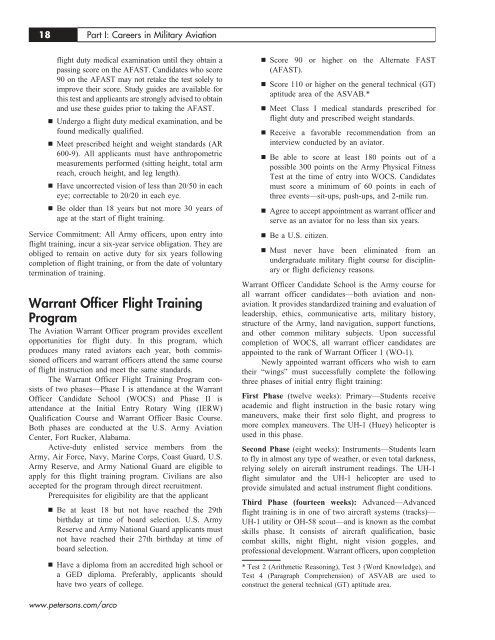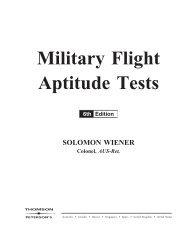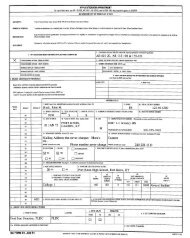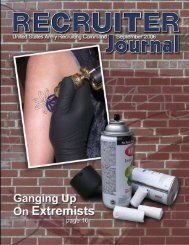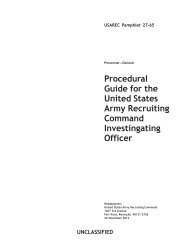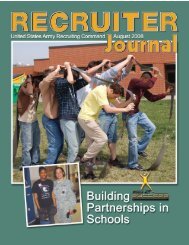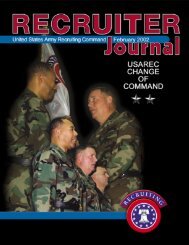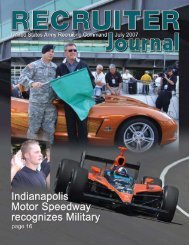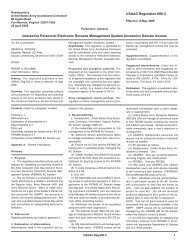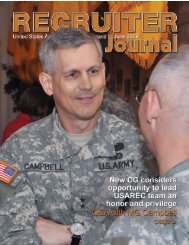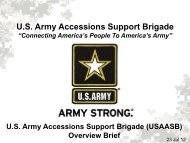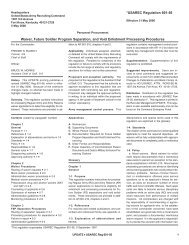Military Flight Aptitude Tests - USAREC - U.S. Army
Military Flight Aptitude Tests - USAREC - U.S. Army
Military Flight Aptitude Tests - USAREC - U.S. Army
Create successful ePaper yourself
Turn your PDF publications into a flip-book with our unique Google optimized e-Paper software.
18 Part I: Careers in <strong>Military</strong> Aviation<br />
flight duty medical examination until they obtain a<br />
passing score on the AFAST. Candidates who score<br />
90 on the AFAST may not retake the test solely to<br />
improve their score. Study guides are available for<br />
this test and applicants are strongly advised to obtain<br />
and use these guides prior to taking the AFAST.<br />
n Undergo a flight duty medical examination, and be<br />
found medically qualified.<br />
n Meet prescribed height and weight standards (AR<br />
600-9). All applicants must have anthropometric<br />
measurements performed (sitting height, total arm<br />
reach, crouch height, and leg length).<br />
n Have uncorrected vision of less than 20/50 in each<br />
eye; correctable to 20/20 in each eye.<br />
n Be older than 18 years but not more 30 years of<br />
age at the start of flight training.<br />
Service Commitment: All <strong>Army</strong> officers, upon entry into<br />
flight training, incur a six-year service obligation. They are<br />
obliged to remain on active duty for six years following<br />
completion of flight training, or from the date of voluntary<br />
termination of training.<br />
Warrant Officer <strong>Flight</strong> Training<br />
Program<br />
The Aviation Warrant Officer program provides excellent<br />
opportunities for flight duty. In this program, which<br />
produces many rated aviators each year, both commissioned<br />
officers and warrant officers attend the same course<br />
of flight instruction and meet the same standards.<br />
The Warrant Officer <strong>Flight</strong> Training Program consists<br />
of two phases—Phase I is attendance at the Warrant<br />
Officer Candidate School (WOCS) and Phase II is<br />
attendance at the Initial Entry Rotary Wing (IERW)<br />
Qualification Course and Warrant Officer Basic Course.<br />
Both phases are conducted at the U.S. <strong>Army</strong> Aviation<br />
Center, Fort Rucker, Alabama.<br />
Active-duty enlisted service members from the<br />
<strong>Army</strong>, Air Force, Navy, Marine Corps, Coast Guard, U.S.<br />
<strong>Army</strong> Reserve, and <strong>Army</strong> National Guard are eligible to<br />
apply for this flight training program. Civilians are also<br />
accepted for the program through direct recruitment.<br />
Prerequisites for eligibility are that the applicant<br />
n Be at least 18 but not have reached the 29th<br />
birthday at time of board selection. U.S. <strong>Army</strong><br />
Reserve and <strong>Army</strong> National Guard applicants must<br />
not have reached their 27th birthday at time of<br />
board selection.<br />
n Have a diploma from an accredited high school or<br />
a GED diploma. Preferably, applicants should<br />
have two years of college.<br />
www.petersons.com/arco<br />
n Score 90 or higher on the Alternate FAST<br />
(AFAST).<br />
n Score 110 or higher on the general technical (GT)<br />
aptitude area of the ASVAB.*<br />
n Meet Class I medical standards prescribed for<br />
flight duty and prescribed weight standards.<br />
n Receive a favorable recommendation from an<br />
interview conducted by an aviator.<br />
n Be able to score at least 180 points out of a<br />
possible 300 points on the <strong>Army</strong> Physical Fitness<br />
Test at the time of entry into WOCS. Candidates<br />
must score a minimum of 60 points in each of<br />
three events—sit-ups, push-ups, and 2-mile run.<br />
n Agree to accept appointment as warrant officer and<br />
serve as an aviator for no less than six years.<br />
n Be a U.S. citizen.<br />
n Must never have been eliminated from an<br />
undergraduate military flight course for disciplinary<br />
or flight deficiency reasons.<br />
Warrant Officer Candidate School is the <strong>Army</strong> course for<br />
all warrant officer candidates—both aviation and nonaviation.<br />
It provides standardized training and evaluation of<br />
leadership, ethics, communicative arts, military history,<br />
structure of the <strong>Army</strong>, land navigation, support functions,<br />
and other common military subjects. Upon successful<br />
completion of WOCS, all warrant officer candidates are<br />
appointed to the rank of Warrant Officer 1 (WO-1).<br />
Newly appointed warrant officers who wish to earn<br />
their “wings” must successfully complete the following<br />
three phases of initial entry flight training:<br />
First Phase (twelve weeks): Primary—Students receive<br />
academic and flight instruction in the basic rotary wing<br />
maneuvers, make their first solo flight, and progress to<br />
more complex maneuvers. The UH-1 (Huey) helicopter is<br />
used in this phase.<br />
Second Phase (eight weeks): Instruments—Students learn<br />
to fly in almost any type of weather, or even total darkness,<br />
relying solely on aircraft instrument readings. The UH-1<br />
flight simulator and the UH-1 helicopter are used to<br />
provide simulated and actual instrument flight conditions.<br />
Third Phase (fourteen weeks): Advanced—Advanced<br />
flight training is in one of two aircraft systems (tracks)—<br />
UH-1 utility or OH-58 scout—and is known as the combat<br />
skills phase. It consists of aircraft qualification, basic<br />
combat skills, night flight, night vision goggles, and<br />
professional development. Warrant officers, upon completion<br />
* Test 2 (Arithmetic Reasoning), Test 3 (Word Knowledge), and<br />
Test 4 (Paragraph Comprehension) of ASVAB are used to<br />
construct the general technical (GT) aptitude area.


